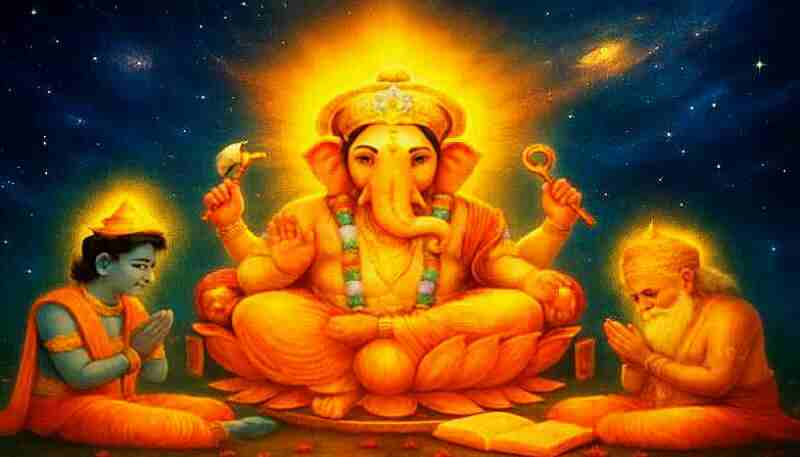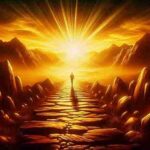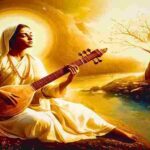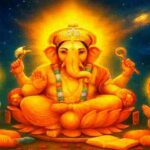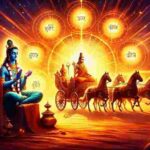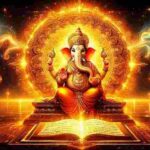The King’s Vow and the Power of Ganesh Purana
The sage said,
“O King! In time, this tree will return to its original form. Until then, I will keep narrating the Ganesha Purana to you. But before we begin, you must worship Lord Ganesha and take a vow to listen to this Purana.”
Following the sage’s instructions, the king made his vow to hear the sacred text. At that very moment, he felt something change within him. All his pain disappeared. When he looked, the spots of leprosy had vanished, and his body was healthy again.
The king was amazed and overwhelmed with gratitude. Falling at the sage’s feet, he said,
“Lord, please bless me by narrating the Ganesha Purana in full detail.”
The sage replied,
“O King! This Purana removes all sins and misfortunes. Listen to it carefully. Only true devotees of Lord Ganesha should listen to it, not others.
In the age of Kali, sins will grow, people will be weak, and life will be short. So, there had to be a way to help. With this thought, Sage Vyasa himself taught me this Purana.
By his grace, I have been fortunate to hear the great deeds of Lord Ganesha.”
He continued,
“Maharaj, Lord Ganesha grants everything to his humble devotees. He always showers his grace on the simple and the egoless. But he never spares the proud and arrogant.
Once, he even humbled the great Sage Vyasa, who was master of all scriptures. Ganesha sees no difference between the high and the low, the weak and the strong, or the wise and the foolish. For him, breaking human pride has become a sacred duty.”
The king, astonished, asked,
“Revered one, how could Sage Vyasa—who is said to be free of all faults and considered an incarnation of Lord Narayana himself—become proud? Please explain this to me.”
Sage Bhrigu answered,
“O King, Sage Vyasa once divided the Vedas into four parts and composed separate collections, making their secrets easier to understand. Scholars worldwide have praised this great work.
Because of such praise, a feeling of pride grew in his heart. Later, to make Vedic wisdom even more accessible, he began composing the Puranas.”
When Vyasa Lost His Wisdom
O King, Lord Ganesha is the Adideva—the first among gods. That is why, since ancient times, it has been a tradition to remember him before starting any work.
But when Sage Vyasa began composing the Puranas, he forgot to invoke and worship Lord Ganesha.
This mistake caused his memory to fade. Important things slipped from his mind. No matter how hard he tried, he could not recall what to write next.
Confused and restless, Vyasa went to Lord Brahma, bowed before him, and said: “Lord! After dividing the Vedas into four parts, I started composing the Puranas.
But now, to my great surprise, my mind has gone blank. I don’t know what to write. Please tell me why my wisdom has left me.”
Brahma meditated for a moment and then replied:
“Vyasa, you have become proud of your knowledge. In that pride, you forgot Lord Ganesha.
At the very beginning of your work, you did not honour him with an invocation. That is why your wisdom is fading. Now, only by pleasing Ganesha can you regain it.”
Vyasa realised his mistake. Yet, he admitted humbly:
“Lord, I know nothing about Ganesha. Please tell me—who is he? What does he look like? What are his divine qualities?”
Brahma answered:
“Son of Satyavati, listen carefully. Ganesha is the supreme and eternal Brahman, beyond all. The scriptures hold seventy million mantras dedicated to him.
Among them, the six-syllable and single-syllable mantras are the simplest. Just looking at a devotee of Ganesha removes obstacles. Once, Lord Shiva himself revealed the method of worship, and I will share it with you now.
At dawn, after bathing in pure water and wearing clean clothes, sit facing the east on a sacred seat. Perform achaman (sipping of water), practice breath control, and meditate.
Then, with the Pranava mantra, chant either the six-syllable or the one-syllable mantra of Ganesha. Continue the chanting until the divine form of Lord Ganesha appears within your heart. By such worship, Ganesha surely becomes pleased.”
Hearing this, Vyasa bowed and asked eagerly:
“Lord Brahma, what exactly is the Ganesha mantra? Who has practised it before me? And what powers or blessings have they gained through it?”
Brahma replied:
“Vyasa, Lord Ganesha is one with Om—the Pranava. All the Vedas sing of him. Om is the seed of all mantras, and through it one chants the name and praises of Ganesha.
The power of Om is limitless. By chanting it, gods, sages, and humans have all attained the fulfilment of their desires.”
Vyasa then said:
“Please explain this in greater detail. My curiosity about the greatness of Lord Ganesha is only increasing. Kindly bless me with deeper knowledge.”
When Ganesha Guided the Tridev
Once, Brahma said, “Dvaipayana! I will tell you an ancient story. Long ago, the Earth was devastated by the mighty forces of wind and water. Everything in creation sank into illusion and became invisible.
At that time, Vishnuji, Shivaji, and I sat together, thinking about what to do. We could not find any solution. Even if we wanted to ask someone, there was no one in sight.
So, we three went to the netherworld and performed intense penance, but it brought no results. Exhausted, we came back to Earth and wandered around. Everywhere we looked, there was darkness.
Finally, we saw a lake. A bright light shone from it, which seemed to make travelling in the sky easy. But we were too hungry and tired to explore further.
As we rested, a magnificent light appeared before us, shining like millions of suns. Looking carefully, we saw Lord Ganesha seated there, the leader of all beings. We bowed and began to praise him:
“Salutations to you, Lord of the universe, master of all! Salutations to you, cause of all causes! Salutations to you, invisible even to the wise, bestower of all boons!”
Hearing our praise, Lord Ganesha said, “Tridev, I am pleased. Ask me for a boon.”
We replied, “Lord, we don’t know what to ask. Please give us instructions. Whatever you say will be the best.”
Ganesha smiled and said, “Brahmaji, Vishnuji, Shivaji, I will assign each of you a task. Brahmaji, you create the universe. Vishnuji, you maintain it. And Shivaji, you will ultimately destroy it.”
He then gave Brahmadev the power to create, Shri Vishnu the power to sustain, and taught him the sacred mantra, “Gum Kshipraprasadanay Namah.” To Shiva, he gave the single-syllable mantra “Gum,” the six-syllable mantra “Vakratundaya Hum,” all the knowledge of the scriptures, and the power to destroy.
Brahmadev humbly said, “Lord, I have never seen or heard of creation before. How can I create it?”
Ganesha replied, “Chaturanan (four-faced one), to understand creation, behold the infinite universes within me. By my grace, you will then be able to perform all tasks effortlessly.”
With Ganesha’s blessing, Brahmadev received divine vision and entered his body. Inside, he saw countless universes. There, he also saw himself, Shri Vishnu, and Shivaji among all living beings.
The same scenes appeared in other universes as well, leaving him amazed. Then Ganesha gently released him.
When Brahma returned outside, no one was there—not Shri Vishnu, not Shiva, not even Ganesha. Yet, he felt ready to create the universe. He instantly grasped the entirety of the Vedas and religious texts.
Since he alone knew the Vedas, everyone praised him. But this praise filled him with immense pride, which obstructed his work.
While creating the universe, many obstacles appeared. Then Brahmadev focused his mind on Lord Ganesha, praising him and saying, “Lord, save me from this danger. Heramba, please bless me.”
At that moment, he heard a divine voice: “Chaturanan, sit under a banyan tree, meditate, and continue chanting my mantra.”
How Brahma Gained Ganesha’s Blessings
Sage Bhrigu once told King Somakanta:
“O King, Brahmadev once explained to Vyasa what had happened to him. After hearing the divine voice, Brahma had a dream. In the dream, after the great flood, only a giant banyan tree was left. On one of its leaves lay a tiny child.
When Brahma looked carefully, he saw the child looked just like Lord Vinayaka. The sight filled him with joy, and he began chanting Ganesha’s mantra.
Soon, the child slowly came near and spoke:
‘Chaturanan (four-faced one), give up all worries and chant my single-syllable mantra ten lakh times. When this practice is complete, you will see me in person.’
The dream ended, and Brahma awoke.
He immediately began the mantra practice with devotion. After he finished the ritual, Ganesha appeared to him. The Lord’s radiant and extraordinary form was so bright that Brahma’s eyes were dazzled, and even his memory faded away.
Then Ganesha’s deep voice echoed:
‘Chaturanan, I had promised to appear before you in your dream. Now I have fulfilled it. Ask me for your desired boon.’
Bowing down, Brahma prayed:
‘Lord, may all obstacles in my work disappear, and may I gain pure knowledge so that I can sing your praises worthily.’
The Lord blessed him with the words, ‘So be it,’ and vanished.
Sage Bhrigu continued:
“After this, Brahma began the work of creation. First, he created fourteen sons from his mind, starting with Marichi, and told them to continue creation. But they, being great sages and absorbed in penance, did not listen to him.
So Brahma himself had to continue the creation. Whatever success he gained in this work was only due to his worship of Lord Ganesha.”
Hearing this, Shaunaka asked Suta:
“Tell me, did only Brahma worship Ganesha, or did other gods also? After all, Vishnu and Shiva are themselves supreme. Vishnu sustains the universe, and Shiva destroys it. They are already powerful in their roles, so why would they worship Ganesha?”
Suta laughed gently and said:
“O sage, I understand why you ask such tricky questions—you do so for the good of all people, and that makes your question most praiseworthy.
Listen: Not only Brahma, but all the gods have worshipped Lord Ganesha at different times. Whenever obstacles appeared in their work, those very gods turned to Ganesha in devotion. Even the goddesses, who embody great powers themselves, worshipped him and attained their goals.”
Lord Vishnu’s Devotion to the Vighneshvara
Hey sage! I have already told you how even Brahma worshipped Lord Ganesha. Lord Vishnu, too, worshipped Ganesha when he faced danger and gained success.
Brahma shared this tale with Vyas, and later Bhrigu repeated it for King Somakanta.
Listen carefully — this story will bring you great joy.
Once, while Brahma was busy creating the world, two demons named Madhu and Kaitabha sprang from the ears of Lord Vishnu.
They became extremely hungry and started looking for food. When they saw Brahma, they mistook him for food and ran toward him.
Brahma was terrified. He begged Yogamaya to wake Lord Vishnu, saying, “Please awaken Vishnu, or these demons will eat me.”
Yogamaya helped, and Vishnu woke from his sleep. Seeing Brahma in danger, Vishnu blew the sound of his conch, the Panchajanya. The sound shook the three worlds.
Hearing it, Madhu and Kaitabha turned their attention toward Vishnu and attacked him. A fierce war began.
The war lasted five thousand years, and the demons still wouldn’t fall. When victory still did not come, Vishnu took on the form of a Gandharva musician.
He went into a forest and began to play the vina. His music was so beautiful that the three worlds were enchanted.
Lord Shiva heard that music too. He sent his followers, Nikumbha and Pushpadanta, to bring the musician to him.
The Gandharva (who was actually Vishnu in disguise) bowed to Shiva and played the vina at his command.
Shiva, Parvati, Ganesha, Kartikeya, and all the other gods were charmed by the tune. Shiva was pleased and said, “Ask for a boon.”
Vishnu asked, “Please grant me the power to destroy the demons Madhu and Kaitabha.”
Shiva laughed and asked, “Why are you here in this disguise? Did you hide yourself because you were afraid of the demons?”
Vishnu replied, “I came like this only to please you, O Ashutosh (Shiva). Now, please tell me the way to defeat those demons.”
Shiva smiled and said, “If you want victory in battle, first please and worship Lord Ganesha.
By worshipping Ganesha, you can make those demons lose their senses with his maya (divine illusion), and then they will fall under your control.”
Vishnu then asked, “How should I worship him? Tell me the method, Parvati-natha, for without the proper ritual, the worship will not succeed.”
Shiva taught him the sixteen-step method of worshipping Lord Ganapati. After learning the ritual, Lord Vishnu worshipped Ganesha for one hundred divine years.
Ganesha was pleased by Vishnu’s great penance. The elephant-faced Lord appeared and said, “I am happy with your tapas.”
He asked Vishnu, “What do you wish for?”
Vishnu replied, “The demons Madhu and Kaitabha have grown very powerful. I cannot control them. O son of Parvati, please show me the way to destroy them.”
Ganesha said, “Vaikuntha-natha, had you prayed to me sooner, the demons would already be gone.”
Vishnu admitted, “Ganesha, I did not know your power. Please grant me your special devotion and help so I can slay those two demons.”
Moved by Vishnu’s plea, Ganesha promised help. He said Shri Vishnu himself would soon kill the two demons. He also said Vishnu’s fear would vanish, and great fame would come to him.
After giving this boon, Ganesha disappeared.
Vishnu returned to the battlefield and saw the two demons ready for war. The demons mocked him for leaving the field earlier.
Vishnu smiled, entered the fight, and destroyed Madhu and Kaitabha.
The place where he had worshipped Ganesha became famous as the Siddha Kshetra — the field of attainment.

